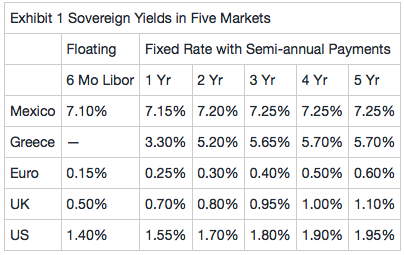问题如下:
Susan Winslow manages bond funds denominated in US Dollars, Euros, and British Pounds. Each fund invests in sovereign bonds and related derivatives. Each fund can invest a portion of its assets outside its base currency market with or without hedging the currency exposure, but to date Winslow has not utilized this capacity. She believes she can also hedge bonds into currencies other than a portfolio’s base currency when she expects doing so will add value. However, the legal department has not yet confirmed this interpretation. If the lawyers disagree, Winslow will be limited to either unhedged positions or hedging into each portfolio’s base currency.
Winslow thinks the Mexican and Greek markets may offer attractive opportunities to enhance returns. Yields in these markets are given in Exhibit 1, along with those for the base currencies of her portfolios. The Greek rates are for euro-denominated government bonds priced at par. In the other markets, the yields apply to par sovereign bonds as well as to the fixed side of swaps versus six-month Libor (i.e., swap spreads are zero in each market). The six-month Libor rates also represent the rates at which investors can borrow or lend in each currency. Winslow observes that the five-year Treasury-note and the five-year German government note are the cheapest to deliver against their respective futures contracts expiring in six months.

Winslow expects yields in the US, Euro, UK, and Greek markets to remain stable over the next six months. She expects Mexican yields to decline to 7.0% at all maturities. Meanwhile, she projects that the Mexican Peso will depreciate by 2% against the Euro, the US Dollar will depreciate by 1% against the Euro, and the British Pound will remain stable versus the Euro. Winslow believes bonds of the same maturity may be viewed as having the same duration for purposes of identifying the most attractive positions.
Based on these views, Winslow is considering three types of trades. First, she is looking at carry trades, with or without taking currency exposure, among her three base currency markets. Each such trade will involve extending duration (e.g., lend long/borrow short) in no more than one market. Second, assuming the legal department confirms her interpretation of permissible currency hedging, she wants to identify the most attractive five-year bond and currency exposure for each of her three portfolios from among the five markets shown in Exhibit 1. Third, she wants to identify the most attractive five-year bond and hedging decision for each portfolio if she is only allowed to hedge into the portfolio’s base currency.
Considering only the US, UK, and Euro markets, the most attractive duration-neutral, currency-neutral carry trade could be implemented as:
选项:
A. Buy 3-year UK Gilts, Sell 3-year German notes, and enter a 6-month FX forward contract to pay EUR/receive GBP
B. Receive fixed/pay floating on a 3-year GBP interest rate swap and receive floating/pay fixed on a 3-year EUR interest rate swap.
C. Buy the T-note futures contract and sell the German note futures contract for delivery in six months.
解释:
B is correct.
In order to be duration-neutral and currency-neutral, the trade must lend long/borrow short in one market and do the opposite (lend short/borrow long), with the same maturities, in another market. The best carry is obtained by lending long/borrowing short on the steepest curve and lending short/borrowing long on the flattest curve. The GBP curve is the steepest and the EUR curve is the flattest. The largest yield spread between these markets is 0.55% at the 3-year maturity, and the narrowest spread is 0.35% at the 6-month maturity. Hence, the best trade is to go long the GBP 3-year/short the EUR 3-year and long the EUR 6-month/short the GBP 6-month. This can be implemented in the swaps market by receiving 3-year fixed/paying 6-month floating in GBP and doing the opposite in EUR (receiving 6-month floating/paying 3-year fixed). The net carry is +0.10% = [(0.95% – 0.50%) + (0.15% – 0.40%)]/2 for six months.
A is incorrect. The FX forward position as stated (pay EUR/receive GBP) corresponds to implicitly borrowing EUR for six months and lending GBP for six months. Correct execution of the trade would require the opposite, receiving EUR and delivering GBP 6 months forward.
C is incorrect. This combination of futures positions does create a duration-neutral, currency neutral carry trade, but it is not the highest available carry. Since the T-note futures price reflects the pricing of the 5-year note as cheapest to deliver, the long position in this contract is equivalent to buying the 5-year Treasury and financing it for 6 months. This generates net carry of 0.275% = (1.95% – 1.40%)/2. Similarly, the short position in the German note futures is equivalent to being short the 5-year German note and lending the proceeds for 6 months, generating net carry of –0.225% = (0.15% – 0.60%)/2. The combined carry is 0.05%, half of what is available on the position in B.
话说,这题是哪个考点啊?强化讲义上有吗?



